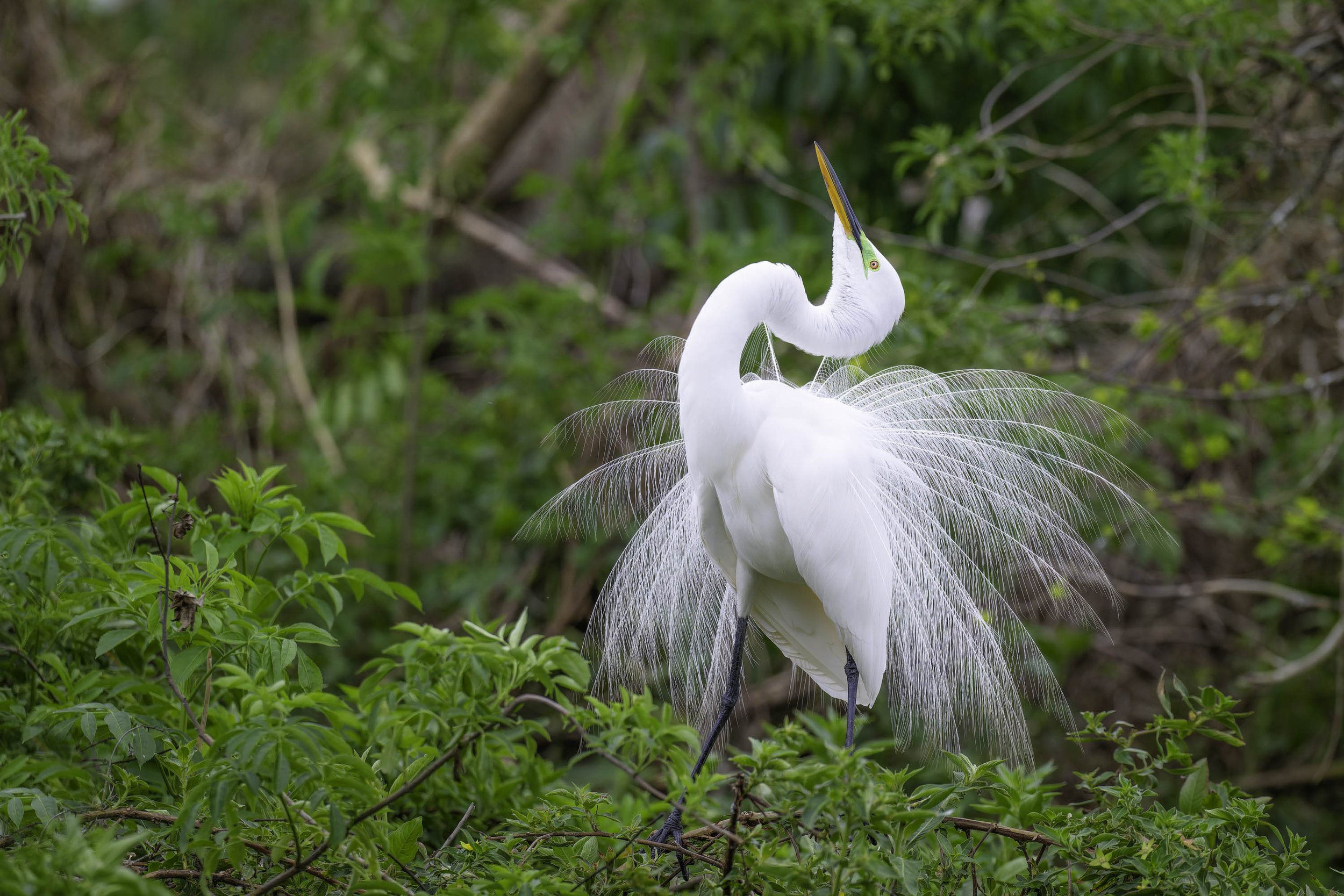A Visit to the Rookery
After giving my camper van a much needed wash I headed to a known rookery in northern Tampa - a site close to where I used to live. In the past this rookery was chock full of Great Egrets and Wood Storks, and a few other birds filled in the gaps. These included Snowy Egrets, Little Blue Heron, Anhinga, Double-crested Cormorants, Glossy Ibis, White Ibis, Boat-tailed Grackle, Black-crowned Night Heron, and Tricolored Heron. I am happy to report I saw all but the Snowy Egrets and Glossy Ibis.
The little island looks like it took a hit from the hurricanes of 2024. A tree popular with Anhinga and Cormorants was down, and there was generally less foliage on the island. But on the whole, everything looked pretty good. I got there around 3pm, stayed about an hour and a half, and was the only person there the whole time.
The Great Egrets looked fantastic with their bright, lime-green lores around the eyes and full nuptial plumes. Unpaired male Great Egrets were doing the Stretch Display all over the rookery. The Stretch Display is a courtship behavior where the bird squats down, bends his neck back over his body, points his bill up, then fully extends his neck all the way towards the sky while fluffing out his neck feathers. He’ll then quickly bring his head back down, gently sway side to side for a few minutes, then do the Stretch Display again. They often combine this with a Bow Display (where they point their heads down), followed by some wing preening.
Great Egret. The middle of the Stretch Display. The next movement is to extend his neck all the way towards the sky while fluffing out his neck feathers. As a photographer you have to be zoomed out because the bird has a very long neck. Nikon Z8 with Nikkor Z 180-600mm f/5.6-6.3 VR lens at 400mm, f/6.0, 1/2000 sec, ISO 2200.
Great Egret. Wing preening is a common behavior in between Stretch Displays. Notice those lime green lores. These will turn back to yellow when breeding season is over. Nikon Z8 with Nikkor Z 180-600mm f/5.6-6.3 VR lens at 520mm, f/6.3, 1/2500 sec, ISO 2500.
Great Egret. Twig Shaking is another common courtship behavior. In this example, the Great Egret grabbed a small branch and giving it a good pull. Nikon Z8 with Nikkor Z 180-600mm f/5.6-6.3 VR lens at 500mm, f/6.3, 1/1250 sec, ISO 1100.
Wood Storks were also in abundance. Some had already nested, some were flying in with nesting material, and some were actively mating - which is very noticeable because they flap their wings a lot and clap their bills loudly. Wood Storks, in my humble opinion are not the prettiest bird. For me, they fall into the same photography category as vultures - the hard to photograph. That being said, here is a wood stork on a nest. Ain’t she pretty. Lol
Wood Stork. Nesting early, the chicks that come from this brood will have a nice head start over other birds in the rookery. Nikon Z8 with Nikkor Z 180-600mm f/5.6-6.3 VR lens at 600mm, f/6.0, 1/1000 sec, ISO 1400.
A few Anhinga were perched in the trees behind the rookery island. While I normally don’t pay attention to Anhingas, right now is the time to photograph them. This female Anhinga was perched on a branch away from the foliage. During breeding season the lores becomes greener, the bill becomes yellower (more pronounced in males), and they get these little tufts of lightly colored feathers on their head and neck.
Anhinga. Nikon Z8 with Nikkor Z 180-600mm f/5.6-6.3 VR lens at 600mm, f/6.3, 1/1000 sec, ISO 1250.
I did spend quite a bit of time photographing an immature Tricolored Heron. He was dancing across the water catching insects, and it was a lot of fun to watch. The only down side was the foliage itself. It just wasn’t pretty. Here’s an example of the bird on dead foliage, which seemed to impact all of my photos of the Tricolored Heron and the Little Blue Heron.
Tricolored Heron. The dead leaves of the perch hurt this photo of a juvenile Tricolored Heron. Nikon Z8 with Nikkor Z 180-600mm f/5.6-6.3 VR lens at 510mm, f/6.3, 1/1250 sec, ISO 2800.
Little Blue Heron. If only there wasn’t yellowish-brown foliage in the water. Nikon Z8 with Nikkor Z 180-600mm f/5.6-6.3 VR lens at 490mm, f/6.3, 1/1250 sec, ISO 1400.
Lastly, a beautiful Black-crowned Night Heron surprised me by coming out in the open where he preened for a good 15 minutes. He looks like he’s ready for a night out in his finest suit.
Black-crowned Night Heron. Nikon Z8 with Nikkor Z 180-600mm f/5.6-6.3 VR lens at 410mm, f/6.0, 1/1000 sec, ISO 1250.
Black-crowned Night Heron. Nikon Z8 with Nikkor Z 180-600mm f/5.6-6.3 VR lens at 510mm, f/6.3, 1/1250 sec, ISO 2800.
Sunday I headed out to Circle B to photograph the well-known Great-Horned Owl that is nesting. That’ll be in my next post - after I get them uploaded and edited.
Until then, happy birding!









